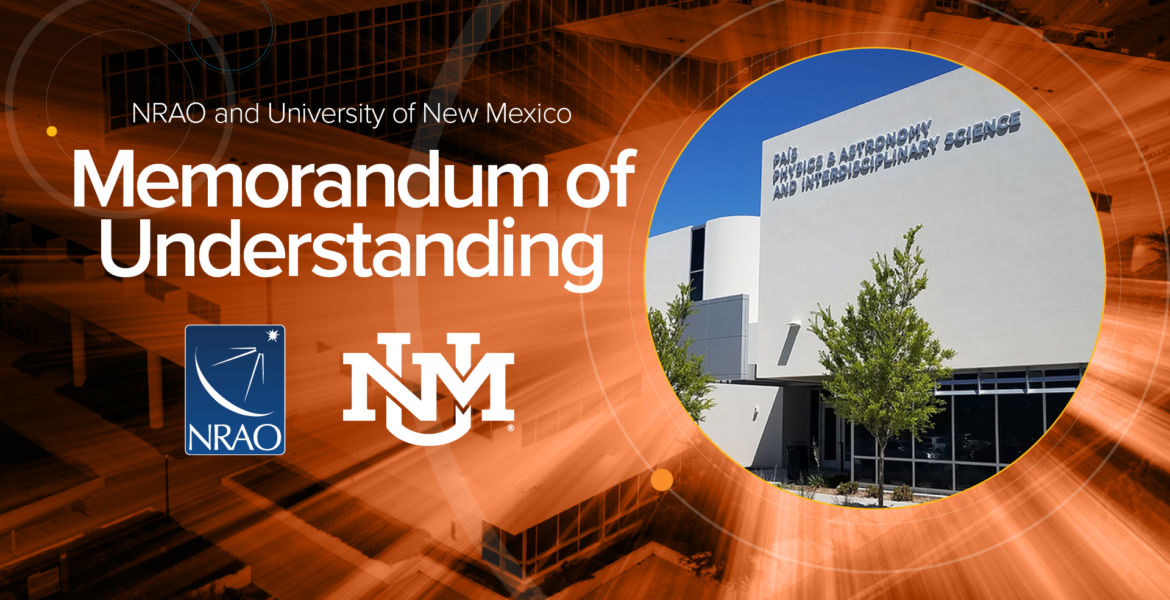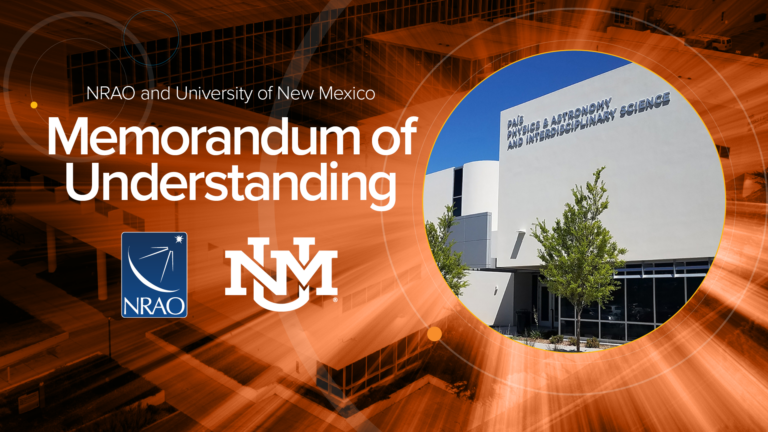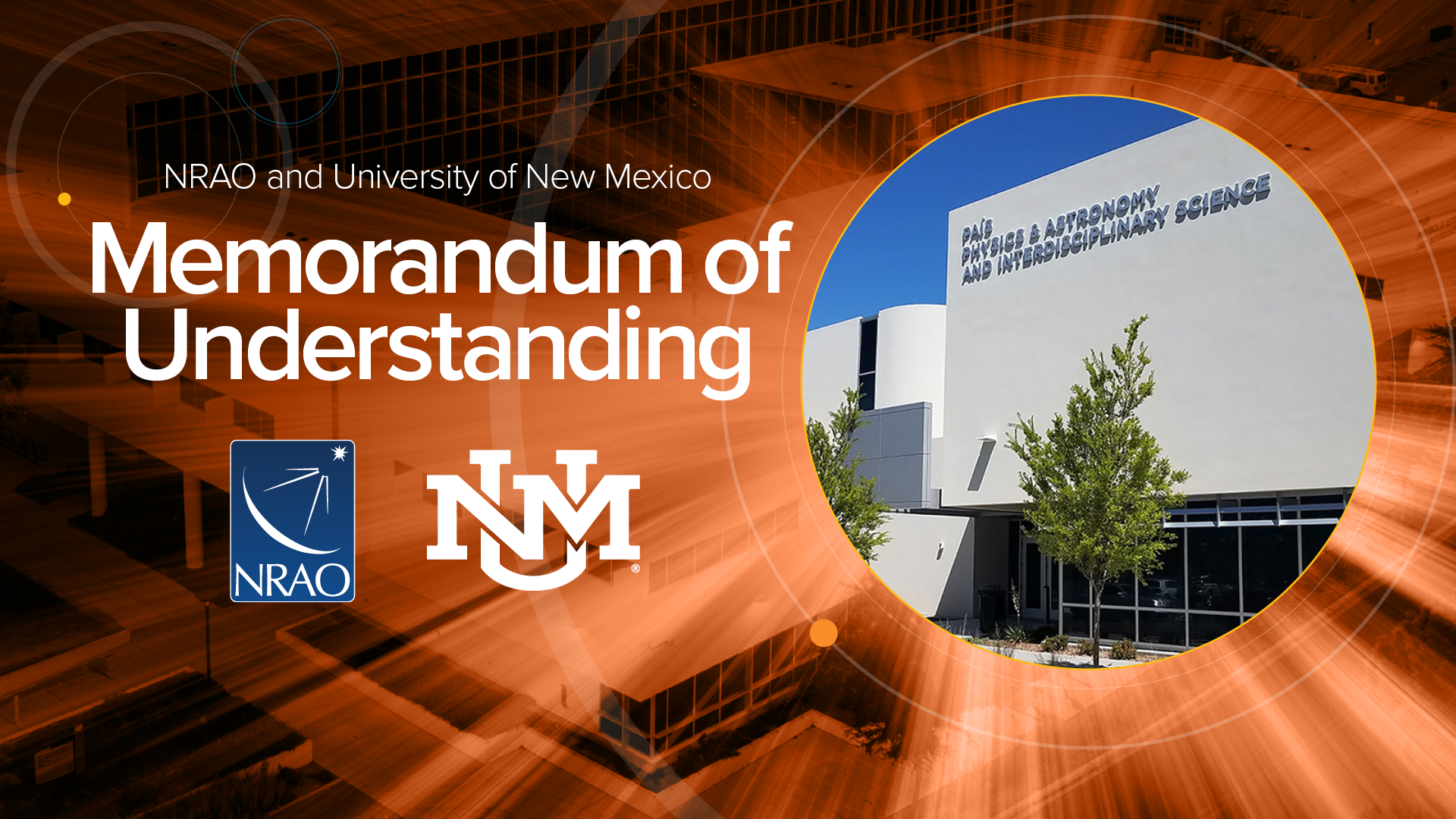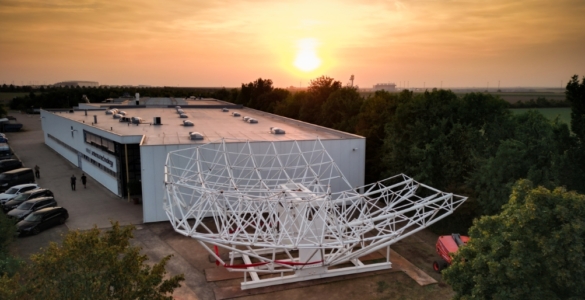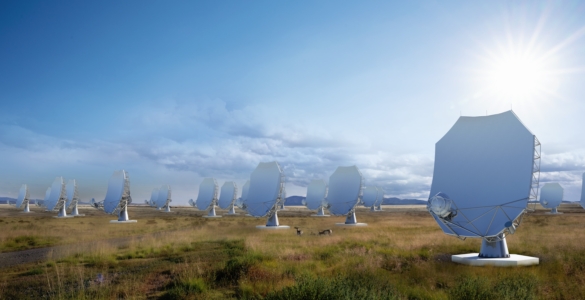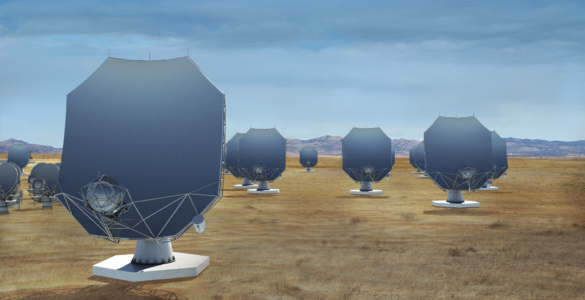Albuquerque, NM, Thursday, September 7, 2023 — The National Radio Astronomy Observatory (NRAO)/Associated Universities, Inc. (AUI), and the University of New Mexico (UNM) have signed a Memorandum of Understanding (MOU) to explore collaborations in support of future U.S. radio astronomy initiatives.
The MOU outlines the shared interests of AUI/NRAO and UNM in increasing professional collaborations amongst scientific and engineering staff through the sharing of facilities and computing resources. The joint effort will actively identify future collaborations related to the next-generation Very Large Array (ngVLA) and Very Long Baseline Array (VLBA).
“Spread across the New Mexico landscape is one of the most iconic and consequential scientific instruments of the world, the Very Large Array. UNM is excited to be working with NRAO on the next generation of this facility, which will probe the universe and reveal new insights about the evolution of galaxies and the formation of terrestrial planets. This work will help to keep our state and our University at the forefront of human understanding of the Universe in which we live,” said James Holloway, UNM provost and executive vice president for academic affairs.
The ngVLA, currently in its design phase thanks to an award from the National Science Foundation, will improve upon the sensitivity and spatial resolution of the Jansky Very Large Array (VLA) and the VLBA by more than an order of magnitude. “A collaboration with the National Radio Astronomy Observatory is a fundamental opportunity for our researchers to innovate and design together critical infrastructure needs that will impact people for generations to come. UNM has a notable track record when it comes to the advancement of space research and science and the involvement of our community to share in our newest innovations and discoveries,” said Ellen Fisher, vice president for research at UNM.
The Astro2020 Decadal Survey Report prioritized the ngVLA as a major ground-based facility whose construction should begin this decade. Once approved, construction on the ngVLA could begin as soon as 2026, with projected early scientific observations starting in 2029 and full scientific operations by 2035. Building on the legacy of the VLA, VLBA, and the Atacama Large Millimeter Array (ALMA), the ngVLA will become the next U.S. flagship radio telescope and ensure that the U.S. remains a global leader in radio astronomy. “This partnership with NRAO to support the next generation Very Large Array could bring more than 200 of the world’s best radio astronomers and engineers to the UNM campus, resulting in unparalleled education and training opportunities for UNM’s astronomy students and hundreds of new, high-paying jobs in New Mexico,” said Chris Lippitt, associate dean for research at the UNM College of Arts & Sciences.
Through this partnership, NRAO and UNM will explore the potential of establishing the UNM College of Arts & Sciences’ Department of Physics & Astronomy as a host site for the ngVLA Data Processing and Science Operations Center. This site will foster close collaboration between NRAO and UNM researchers, and will also provide UNM students the opportunity to work closely with and learn from the world-class radio astronomers and engineers at AUI/ NRAO. “This memorandum of understanding between NRAO and UNM strengthens our existing partnership, is the foundation for significant cooperative work on the ngVLA, and will help ensure that the state of New Mexico remains at the center of the radio astronomy world,” said Eric Murphy, the Project Scientist for ngVLA. “We look forward to an exciting future ahead with UNM.”
This partnership is directly aligned with UNM’s 2040 goal to “Advance New Mexico” by being an economic driver for the state of New Mexico, but will also advance future leaders in radio astronomy, data science, high performance computing, and engineering. “With National Science Foundation support and Associated Universities, Inc. oversight, NRAO telescopes have put New Mexico at the heart of international radio astronomy,” said Tony Beasley, Director of NRAO. “Working with UNM gives us an even more solid foundation to create the next great instrument for the scientific community.”
The MOU also explores the potential for collaboration between UNM and AUI/NRAO to support the computational infrastructure needs for the VLBA Back End Retrofit (VBER) project. The VBER project aims to upgrade critical end-of-life electronics and improve capabilities at all 10 VLBA antenna sites.
For more information, please contact:
AUI/NRAO:
Technical Point of Contact: Eric Murphy, ngVLA Project Scientist, NRAO, emurphy@nrao.edu
Administrative Point of Contact: Richard Sakshaug, Contracts and Procurement Manager, rsakshau@nrao.edu
UNM:
Technical Point of Contact: Dr. Christopher D. Lippitt, Associate Dean for Research, UNM College of Arts & Sciences, clippitt@unm.edu
Administrative Point of Contact: Dr. Ellen Fisher, Vice President for Research, University of New Mexico, erfisher21@unm.edu
About NRAO:
The National Radio Astronomy Observatory (NRAO) is a facility of the National Science Foundation (NSF), operated under cooperative agreement by Associated Universities, Inc. Furthering NSF’s mission to advance the progress of science, the NRAO enables research into the Universe at radio wavelengths and provides world-class telescopes, instrumentation, and expertise to the scientific community. NRAO’s mission includes a commitment to broader, equitable, inclusive participation in science and engineering, training the next generation of scientists and engineers, and promoting astronomy to foster a more scientifically literate society. NRAO operates three research facilities: the Atacama Large Millimeter/submillimeter Array (ALMA), the Karl G. Jansky Very Large Array (VLA), and the Very Long Baseline Array (VLBA), which are available for use by scientists from around the globe, regardless of institutional or national affiliation. NRAO welcomes applicants who bring diverse and innovative dimensions to the Observatory and to the field of radio astronomy. For more information about NRAO, go to National Radio Astronomy Observatory .
About UNM:
The University of New Mexico (UNM) is a public research university in Albuquerque, New Mexico. Founded in 1889 as the state’s flagship institution, UNM offers over 200 degree and certificate programs across 15 academic units. As the only academic institution in the state of New Mexico with a Carnegie Classification of Very High Research Activity (R1), UNM plays a critical role in educating the state’s residents and in driving its economy.
About the College of Arts & Sciences:
The College of Arts & Sciences is the largest academic unit on UNM’s campus, generating approximately $40 million in research funding each year. With over 45 majors and 68 concentrations spanning across 24 departments and schools as well as 26 academic and research programs, the College has established itself as a catalyst for academic and research excellence and innovation at UNM and throughout the state of New Mexico.
About the Department of Physics & Astronomy:
The UNM Department of Physics & Astronomy at the College of Arts & Sciences generates approximately $11 million in research funding each year. Located in the state-of-the-art Physics & Astronomy and Interdisciplinary Science (PAÍS) building, the department provides their students with a broad depth of experience that puts them well ahead of their peers at similar institutions.
Media Contact:
Jill Malusky
Public Information & News Manager, NRAO
304-460-5608
Irene Gray, MPA
Marketing & Communications Manager
UNM College of Arts and Sciences Office of Research


